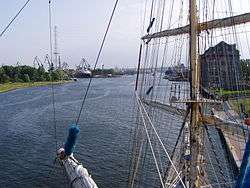Port of Gdańsk
The Port of Gdańsk is a seaport located on the southern coast of Gdańsk Bay in the city of Gdańsk, extending along the Vistula estuary Martwa Wisła (Dead Vistula), Port Channel and Kashubia Canal. It is one of the largest seaports on the Baltic Sea.
| Port of Gdańsk | |
|---|---|
 | |
| Location | |
| Country | Poland |
| Location | Gdańsk |
| Coordinates | 54°23′36″N 18°40′12″E |
| UN/LOCODE | PLGDN[1] |
| Details | |
| Operated by | Gdańsk Seaport Authority |
| Owned by | Government of Poland |
| Size of harbor | 412.56 ha (1,019.5 acres) |
| Land area | 653 ha (1,610 acres) |
| Size | 1,065.56 ha (2,633.1 acres) |
| Statistics | |
| Annual cargo tonnage | |
| Annual container volume | |
| Website Port of Gdańsk | |
Entrance to the Inner Port

Port of Gdańsk from mainmast of Fryderyk Chopin
.jpg)
Car carrier in the entrance to the inner port, as seen from the nearby beach.
The Port of Gdańsk is divided into two parts, the Inner and Exterior Port.
Inner Port
- Port of Gdańsk Cargo Logistics S.A. - universal port operator providing handling and storage services for bulk and general cargo
- Gdańsk Container Terminal – providing feeder services
- Ferry terminals
- Polferries
- Westerplatte
- Phosphates terminal
- Liquid and bulk sulphur terminal
- Fruit handling terminal in the Port Free Zone
The Port of Gdańsk has specialized cargo handling equipment and port infrastructure, enabling among others the handling of grain, fertilizers, lumber, ore, steel and containers, as well as ro-ro vessel servicing.
Exterior — Northern Port
Northern Port is located directly in the water basins of Gdańsk Bay. The largest vessels with a capacity of up to 300,000 tonnes deadweight (DWT) and draft to 15 m that enter the Baltic Sea can be serviced here.
- Coal terminal
- Naftoport — crude oil, heating oils, fuels terminal
- LPG terminal
- Deepwater Container Terminal
Trans-shipments
- 1978 – 2.8 million ton
- 2000 – 16.5 million ton
- 2001 – 17.8 million ton
- 2002 – 17.4 million ton
- 2003 – 21.3 million ton
- 2004 – 23.3 million ton
- 2005 – 23.3 million ton
- 2006 – 22.4 million ton
- 2007 – 19.8 million ton
- 2008 – 17.8 million ton
- 2009 – 18.9 million ton[2]
- 2010 – 27.2 million ton[3]
- 2011 – 25.3 million ton[4]
- 2012 – 26.9 million ton[5]
- 2013 - 30.0 million ton
- 2014 - 32.3 million ton
- 2015 - 35.9 million ton
- 2016 - 37.3 million ton [6]
- 2017 - 40.6 million ton [7]
- 2018 - 49.0 million ton
gollark: That's stupid.
gollark: "Conventional thought" includes stuff like the law of the excluded middle, which is important or any statement you make about god is basically meaningless because the opposite is true.
gollark: God can also be beetroot for entirely arbitrary reasons.
gollark: You can say "god is good", but if you drop logic, that doesn't mean that god is not also bad.
gollark: And also the ability to meaningfully describe gods.
See also
References
- "UNLOCODE (Pl) - POLAND". service.unece.org. Retrieved 26 April 2020.
- Cargo statistics, portgdansk.pl.
- portgdansk.pl.
- Cargo statistics, portgdansk.pl.
- Cargo statistics, portgdansk.pl.
- Cargo statistics, portgdansk.pl
- Cargo statistics, portgdansk.pl
External links
| Wikimedia Commons has media related to Port of Gdańsk. |
This article is issued from Wikipedia. The text is licensed under Creative Commons - Attribution - Sharealike. Additional terms may apply for the media files.
